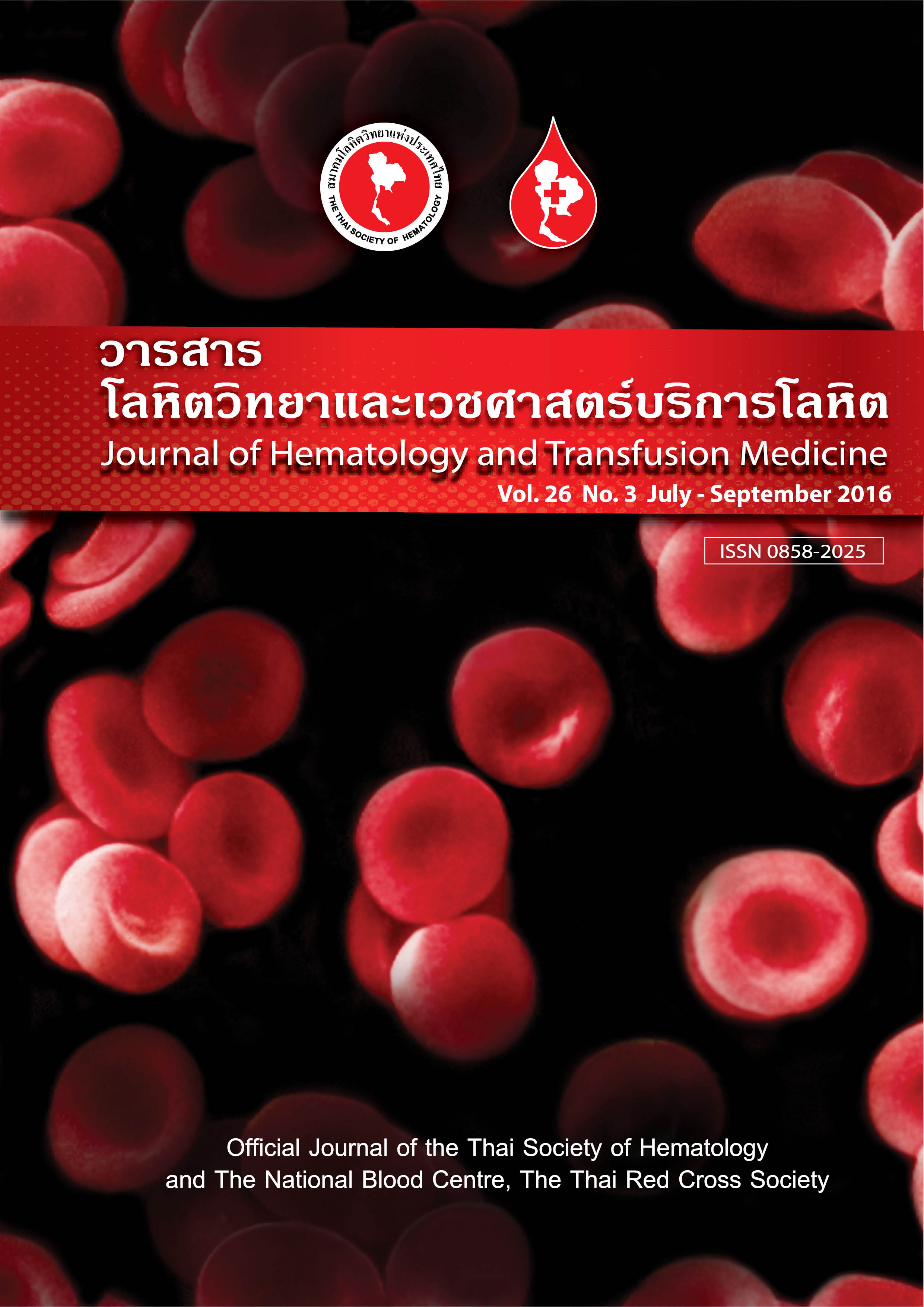การศึกษาชนิดแอนติบอดีต่อเกล็ดเลือดของผู้ป่วยที่ส่งตรวจที่ศูนย์บริการโลหิตแห่งชาติ สภากาชาดไทย
Keywords:
Human platelet antibody detection, Human leukocyte antigens, Human platelet antigensAbstract
บทคัดย่อ
การเกิด alloantibodies ต่อแอนติเจนบนผิวเกล็ดเลือดมีความสำคัญในผู้ป่วยที่มีเกล็ดเลือดต่ำ การตรวจชนิดของแอนติบอดีต่อทั้ง human leukocyte antigens; HLA และ human platelet antigens; HPA ช่วยในการวินิจฉัยภาวะเกล็ดเลือดต่ำ และการจัดหาเกล็ดเลือดที่เข้ากันได้และเหมาะสมให้กับผู้ป่วย ผู้วิจัยทำการศึกษาข้อมูลย้อนหลังของผู้ป่วยที่ส่งตรวจแอนติบอดีต่อเกล็ดเลือด ณ ศูนย์บริการโลหิตแห่งชาติ สภากาชาดไทย แบ่งเป็น 2 กลุ่มคือ ผู้ป่วยทารกแรกคลอดที่มีภาวะเกล็ดเลือดต่ำ จำนวน 34 ราย และผู้ป่วยที่มีเกล็ดเลือดต่ำ จำนวน 508 ราย ผู้ป่วยที่พบแอนติบอดีด้วยวิธี solid phase red cell adherent assay (SPRCA) จะตรวจแยกชนิดของแอนติบอดีด้วยเทคนิค monoclonal antibody-specific immobilization of platelet antigens (MAIPA) ผลการศึกษาจากการตรวจด้วยวิธี SPRCA พบว่า ผู้ป่วยทารกแรกคลอดพบแอนติบอดีต่อ HLA จำนวน 14 ราย นอกจากนี้รายที่ซีรัมมารดาให้ผลลบจำนวน 20 ราย เมื่อทดสอบ crossmatch กับเกล็ดเลือดบิดาให้ผลบวกจำนวน 5 ราย ซึ่งมีสาเหตุจากแอนติบอดีต่อ HLA จำนวน 3 ราย แอนติบอดีชนิด unidentified antibody จำนวน 1 ราย และอีก 1 รายมีสาเหตุจากหมู่เลือด ABO เข้ากันไม่ได้ กลุ่มผู้ป่วยที่มีภาวะเกล็ดเลือดต่ำที่ตรวจพบแอนติบอดีด้วยวิธี SPRCA จำนวน 324 ราย เป็นแอนติบอดีต่อ HLA จำนวน 273 ราย รองลงมาคือแอนติบอดีต่อ HLA ร่วมกับ HPA จำนวน 43 ราย และแอนติบอดีต่อ HPA จำนวน 8 ราย ตามลำดับ เมื่อพิจารณาผลการแยกชนิดของแอนติบอดีเพิ่มเติมด้วยวิธี MAIPA ร่วมกับการตรวจจีโนไทป์ของ HPA ในกลุ่มผู้ป่วยที่พบแอนติบอดีต่อทั้ง HLA และ HPA พบว่า สามารถระบุความจำเพาะของแอนติบอดีต่อ HPA ของผู้ป่วยได้จำนวน 14 ราย โดยสรุป ผู้ป่วยที่มีภาวะเกล็ดเลือดต่ำส่วนใหญ่พบเป็นแอนติบอดีต่อ HLA แต่ผู้ป่วยที่พบว่ามีแอนติบอดีต่อ HPA ร่วมกับ HLA ควรตรวจจีโนไทป์ของ HPA เพิ่มเติมเพื่อช่วยในการแปลผลชนิดของแอนติบอดีต่อ HPA ซึ่งจะเป็นประโยชน์ในการวินิจฉัยโรคและการจัดหาเกล็ดเลือดที่เหมาะสมและปลอดภัยให้กับผู้ป่วย
Abstract
Alloantibodies directed against platelet surface antigens are clinically important, especially in patients with thrombocytopenia. Detection of antibody specific to human leukocyte antigens (HLA) and human platelet antigens (HPA) is helpful for the diagnosis and finding compatible platelets. This retrospective study aimed to determine antibody against platelet surface antigens found in patients whose samples were sent to test at the National Blood Centre, Thai Red Cross Society. They were divided into 2 groups: 34 FNAIT and 508 patients with thrombocytopenia. Positive antibody testing by solid phase red cell adherent assay (SPRCA), monoclonal antibody-specific immobilization of platelet antigens (MAIPA) was additionally performed to identify HPA antibody specificity. Regarding antibody detection by SPRCA, it was found that 14 FNAIT had HLA antibodies; while, the others were negative. When paternal platelet crossmatch was performed in these 20 maternal sera, 5 samples were positive consisting of 3 HLA antibodies, 1 unidentified antibody and 1 ABO incompatibility. Among 324 thrombocytopenic patients with positive platelet antibodies tested by SPRCA, 273 were HLA antibodies, followed by 43 of combined HLA and HPA antibodies, and 8 were HPA antibodies, respectively. According to additional testing for HPA antibody specificities using MAIPA and HPA genotyping, we found that antibody specific to HPA could be identified in 14 patients who had combined HLA and HPA antibodies. In conclusion, the most common antibodies found in patients with thrombocytopenia were HLA antibodies. However, HPA genotyping is suggested in patients who had combined HLA and HPA antibodies to provide definitive diagnosis and appropriate platelet transfusions.



